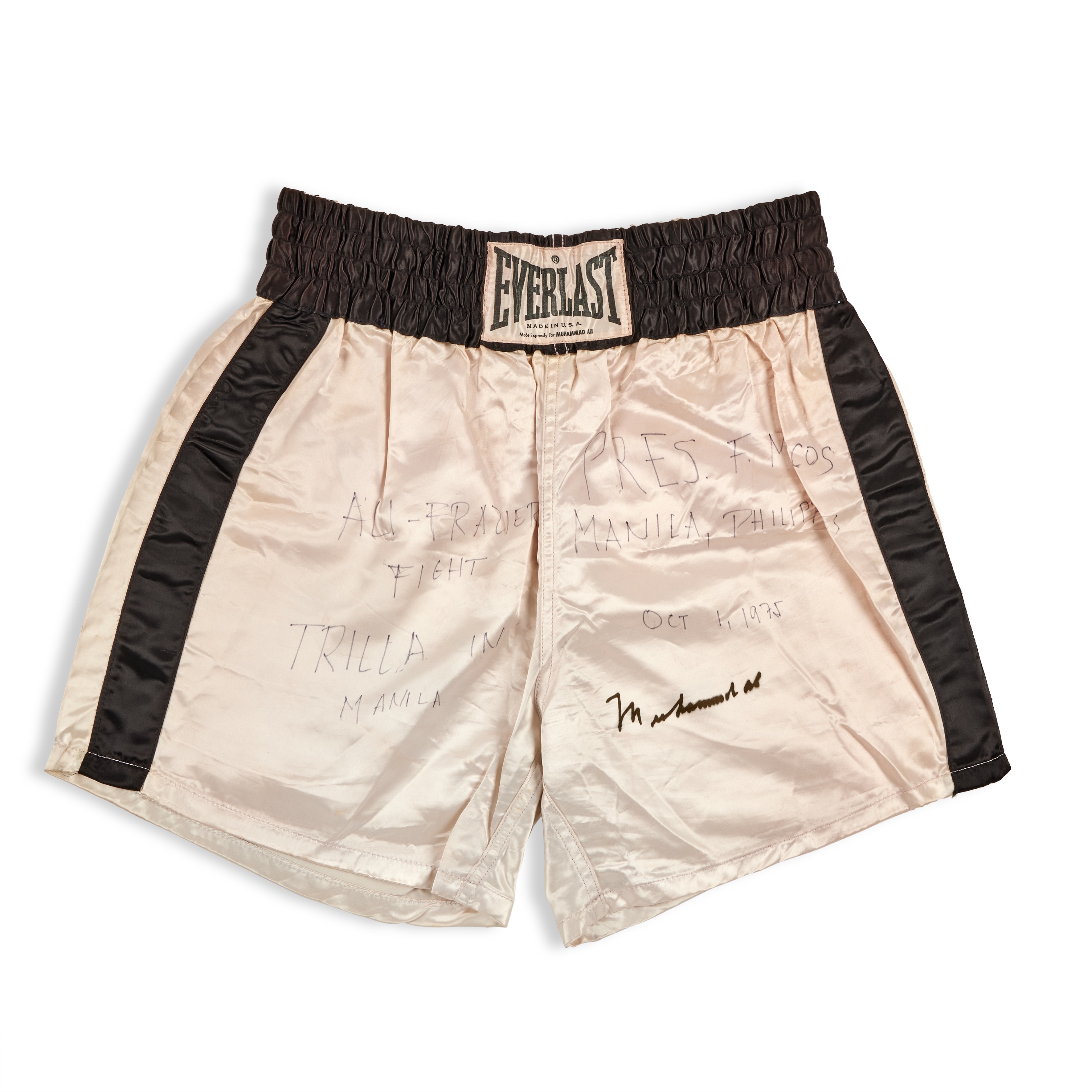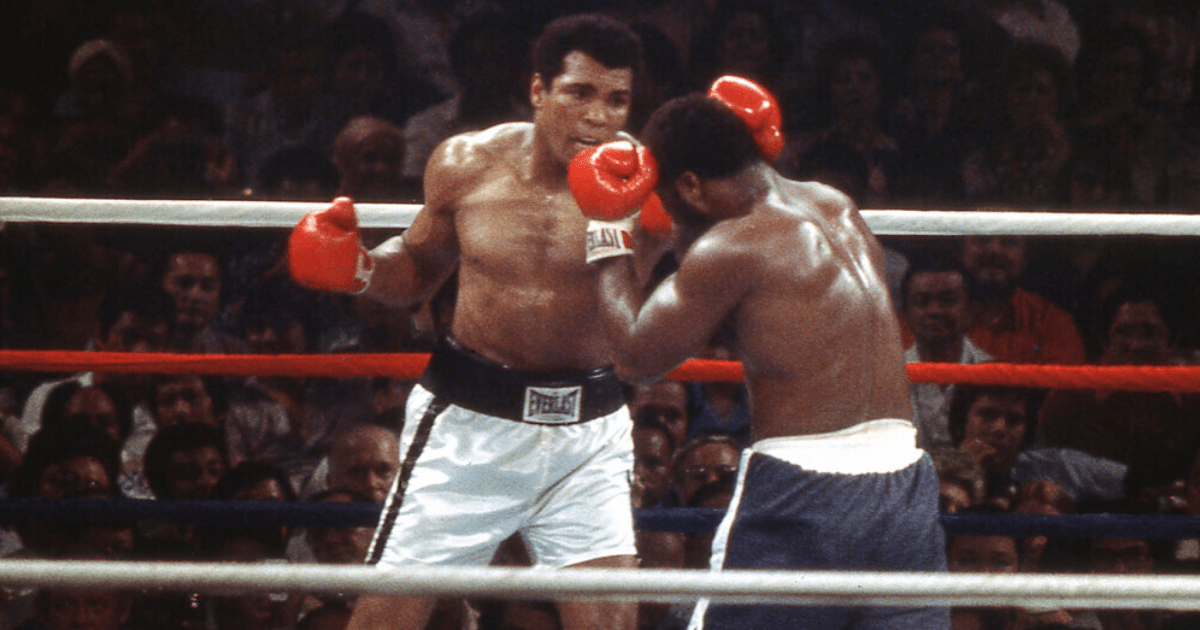Legendary Boxing Memorabilia
Muhammad Ali’s shorts from his iconic 'Thrilla in Manila' fight against Joe Frazier are set to hit the auction block and could potentially fetch a staggering £5 million.
Historic Fight
The late boxing legend famously defeated his rival in 14 grueling rounds back in 1975, describing the intense battle in scorching 120-degree heat as "the closest thing to dying."
High-Stakes Auction
The signed pair of Ali's classic white with black trim Everlast shorts will be auctioned off at Sotheby’s New York Sports Week, with bidders expected to vie for the historic piece of sports memorabilia.
Legacy of Champions
Ali reflected on the unforgettable match, stating, "It was like death. Closest thing to dying that I know of." The event, held in the Philippines, pushed both fighters to their limits during the 42-minute showdown under scorching conditions.

Enduring Impact
The aftermath of the 'Thrilla in Manila' took a toll on both Ali and Frazier, with Frazier's vision permanently affected and Ali later battling Parkinson's disease before his passing at age 74 in 2016.
Auction Highlights
The auction will also feature Michael Jordan's Air Jordan 11s from Game 5 of the 1996 NBA Finals, valued at up to £317,000 ($400,000), alongside a collection of sneakers worn by basketball legends.
Frequently Asked Questions
How important are physical conditioning and training for professional boxers?
Professional boxing requires a high level of physical conditioning. Sport requires high levels strength, speed endurance and agility. Professional boxers must engage in a tailored fitness program that includes aerobic and anaerobic exercises, strength and resistance training, and flexibility workouts. The ability of a boxer to train and perform effectively is compromised without a superior level of physical conditioning.
What are some of the most important components in a boxer’s training regime?
A boxer’s regular training routine usually consists of multiple key components. This includes technical skill development and tactical drills. It also includes strength and condition, sparring sessions, and mental prep. Technique-focused workouts improve punch accuracy and defensive maneuvers, while tactical drills develop fight strategies. Sparring allows for practical combat experience. Conditioning exercises boost athleticism. Mental training focuses on building confidence, focus, and resilience.
What should you look for when choosing a boxing trainer?
A boxing coach should have experience in the sport, be able to work with other boxers successfully, have a compatible coaching style, as well as a solid understanding of its technical and strategic components. A good coach will also stress safety, conditioning and personal growth. To reach your boxing potential, you need a coach who is able to motivate and communicate well.
Anyone can learn how to box professionally.
Not everyone can compete at the professional level. Professional boxing demands a unique combination of talent as well as physical abilities, mental strength and dedication. Boxers who are interested in the sport must be prepared to accept the inherent dangers. A comprehensive screening by a trainer can help determine if someone has the potential for a professional career in boxing.
How important is mental toughness to professional boxing?
In professional boxing, mental toughness is just as important as physical fitness. Resilience, focus, pressure-handling ability, and psychological fortitude are all required in the sport. Mental preparation involves visualization, stress management techniques, and developing a strong mindset to confront the challenges within the ring. A boxer without mental toughness may find it difficult to perform well under the extreme conditions of a professional competition.
How do you progress from amateur to Professional Boxing?
As you transition from amateur to pro boxing, your competition intensity, mental preparation, and training will increase significantly. An amateur boxer must establish a strong track record of performance, typically honing skills in various local and national competitions. To be able to secure professional bouts, it is important to have a professional license in boxing and align yourself with experienced managers or trainers.
How long does it typically take to become a professional boxer?
The time it takes to become a professional boxer can vary widely. The length of time to become a professional can be affected by the person’s initial skill level, his or her ability to adapt and their training. It can take a number of years to develop the necessary skills and gain enough amateur experience. Some people may develop more quickly while others will take more time.
Statistics
- Cardiovascular fitness is critical, with a focus on high intensity interval training, comprising up to 40% of a boxer’s conditioning program.
- As per recent surveys, only about 17% of professional boxers reach a title shot opportunity in their careers.
- Research shows that a boxer’s reaction time is typically under 0.25 seconds, honed through repetitive drills and sparring.
- The average age for boxers to turn professional is between 18 to 25 years, though many continue to compete well into their 30s and beyond.
- Nutrition experts emphasize that over 70% of a boxer’s diet should focus on carbohydrates and proteins for energy and recovery.
- A study showed that most professional boxers have spent more than 4 years in training before their first professional bout.
- Around 60% of professional boxers supplement their income with other activities or jobs, due to variability in fight earnings.
External Links
precisionstriking.com
wbcboxing.com
boxingscene.com
ibhof.com
teamusa.org
proboxing-fans.com
expertboxing.com
How To
How to Get Your First Professional Boxing Fight
Landing your first professional boxing fight requires a combination of training, networking, and marketing yourself as a fighter. You can gain attention by displaying your amateur skills. Connect with gym owners, promoters and trainers who may have opportunities to offer or be aware of openings in fight cards. Create promotional material, like a highlight reel of your fights, and maintain an active social media presence to build your brand. Final tip: Be ready to battle at all times so you can seize any opportunity that comes your way.

